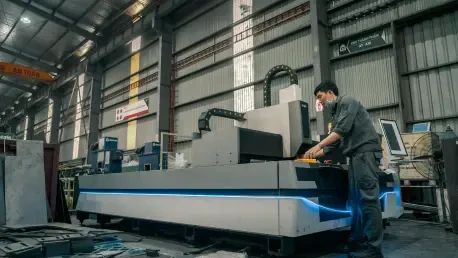Introduction to CMMC: A Critical Deadline for Manufacturers
The defense industrial base (DIB) faces an unprecedented cybersecurity challenge, with over 200,000 businesses at risk of losing critical contracts due to escalating cyber threats targeting sensitive data. On September 10, the Department of Defense (DoD) issued its final rule for the Cybersecurity Maturity Model Certification (CMMC), a framework designed to safeguard intellectual property and operational integrity across the supply chain. This marks a pivotal moment for manufacturers, as starting November 10, CMMC requirements will be embedded in contracts, demanding immediate attention.
This deadline is not a distant concern but an urgent reality affecting every tier of the defense supply chain. From large prime contractors to small machine shops producing subassemblies, compliance is now a prerequisite for doing business with the DoD. Small and mid-sized manufacturers, often lacking robust cybersecurity resources, are particularly vulnerable to being locked out if action is not taken swiftly.
The focus here is to unpack why compliance is essential, what it entails for manufacturers, and how to achieve it through actionable steps. With the enforcement date approaching, the stakes are high, and understanding the path forward can mean the difference between securing contracts and losing market access. This guide aims to equip manufacturers with the knowledge needed to navigate this critical transition.
Why CMMC Compliance Is Non-Negotiable for Manufacturers
CMMC serves as a vital shield for the DIB, protecting against cyber threats that aim to steal proprietary designs and disrupt manufacturing processes. Adversaries increasingly target sensitive information like Federal Contract Information (FCI) and Controlled Unclassified Information (CUI), making standardized cybersecurity measures a necessity. For manufacturers, adhering to these standards ensures the security of both their operations and the broader defense ecosystem.
Failure to comply carries severe repercussions, including the inability to bid on new contracts or retain existing ones. Noncompliance can fracture long-standing relationships with defense primes and subcontractors, as the requirements cascade through every level of the supply chain. This is not merely a regulatory hurdle but a fundamental condition for remaining competitive in the defense sector.
On the flip side, early compliance offers a distinct market edge, positioning manufacturers as trusted partners in a crowded field. The CMMC framework includes three maturity levels—Foundational (Level 1), Advanced (Level 2), and Expert (Level 3)—each tailored to the sensitivity of data handled. While Level 1 focuses on basic FCI safeguards, Level 2 aligns with NIST SP 800-171 for CUI protection, and Level 3 targets highly sensitive data with advanced controls, ensuring relevance for diverse manufacturing roles.
Practical Steps for Manufacturers to Achieve CMMC Compliance
Achieving CMMC compliance demands a structured approach, especially with the tight timeline manufacturers face. The following seven steps provide a roadmap to meet these requirements, helping businesses avoid exclusion from defense contracts. Each step addresses a specific aspect of preparation, from initial assessment to final certification.
Given the November 10 deadline, urgency is paramount. Manufacturers must prioritize these actions to secure their place in the supply chain, as delays could result in missed opportunities. Proactive engagement with the process not only ensures compliance but also builds resilience against cyber risks.
Step 1: Determine Your Required CMMC Level
Identifying the appropriate CMMC level is the foundation of compliance efforts. This depends on the type of data a manufacturer handles, whether it’s FCI, which requires Level 1 safeguards, or CUI, often necessitating Level 2 alignment with NIST SP 800-171. For those dealing with highly sensitive information, Level 3 may apply, though this is less common among smaller firms.
Understanding data classification is crucial, as even seemingly routine technical drawings or specifications from the DoD can elevate a manufacturer’s required level. This step sets the scope of cybersecurity measures needed, guiding subsequent resource allocation. Manufacturers must review contracts and data flows to pinpoint their exact obligations under the framework.
Example: Identifying Level for a Small Machine Shop
Consider a small machine shop that receives DoD technical drawings for producing components. Since these documents contain CUI, the shop falls under Level 2 requirements, necessitating more robust protections than basic FCI safeguarding. This determination shapes the shop’s compliance strategy, focusing efforts on specific security controls.
Step 2: Map Assets and Sensitive Data Flows
Once the required level is clear, manufacturers must map where sensitive data resides and how it moves through their operations. This includes not just office IT systems but also shop floor equipment like CNC machines, industrial PCs, and ERP platforms that may store or process defense-related information. A thorough mapping narrows the compliance scope to critical systems.
This process often reveals unexpected vulnerabilities, such as networked devices on production lines that handle CUI. By pinpointing these areas, manufacturers can avoid overextending resources on non-sensitive systems, focusing instead on protecting key assets. Accurate mapping forms the basis for targeted cybersecurity improvements.
Case Study: Data Mapping in a Mid-Sized Fabricator
A mid-sized metal fabricator discovered during mapping that CUI was present on networked industrial PCs used for design reviews. By isolating these systems, the company reduced its compliance scope, applying security measures only where necessary. This streamlined approach saved time and minimized operational disruption.
Step 3: Design a Secure Technical Architecture
With data flows mapped, the next task is designing a secure architecture to protect sensitive information. Options include creating enclaves for isolated data handling, adopting secure cloud solutions, or implementing enterprise-wide security tailored to manufacturing environments. The choice depends on how data integrates with production processes.
For many manufacturers, isolating DoD-related data to specific workstations or servers can limit the scope of compliance efforts. However, if data permeates broader systems like shop floor networks, a more comprehensive design may be needed. This step ensures that technical solutions align with both operational needs and CMMC standards.
Real-World Application: Enclave for Engineering Workstations
A manufacturer handling DoD designs opted to restrict sensitive data to engineering workstations within a secure enclave. This setup minimized the number of systems requiring stringent controls, reducing costs and complexity. Such targeted designs demonstrate how architecture can simplify compliance without compromising security.
Step 4: Implement Compliant IT Platforms
Implementing IT platforms that meet federal security requirements is a critical milestone. This may involve adopting government-compliant cloud environments, adding encryption to file servers for CAD data, or segmenting networks to protect production equipment. These measures ensure systems align with CMMC expectations.
Older manufacturing equipment, often not designed with cybersecurity in mind, can pose challenges during implementation. Upgrading or retrofitting such systems to include modern security features is often necessary. Early adoption of compliant platforms prevents costly rework and strengthens overall data protection.
Example: Upgrading Shop Floor Security
A plastics processor upgraded its shop floor security by encrypting CAD file servers to comply with CMMC standards. This targeted enhancement safeguarded sensitive design data without overhauling the entire IT infrastructure. Such practical upgrades illustrate how focused investments can achieve compliance efficiently.
Step 5: Engage Qualified Cybersecurity Support
Many small and mid-sized manufacturers lack in-house cybersecurity expertise, making external support essential. Partnering with managed service providers or consultants can address gaps in knowledge, offering guidance on securing networked machines and configuring remote access. These partnerships accelerate the compliance process.
External experts also bring familiarity with NIST standards, which underpin CMMC requirements, ensuring alignment with federal expectations. For resource-constrained firms, such support is a cost-effective way to navigate complex regulations. Choosing qualified partners can make the difference between timely compliance and falling behind.
Success Story: Partnering for Compliance
A small manufacturer collaborated with a cybersecurity consultant to secure remote access for maintenance vendors, aligning with NIST guidelines. This partnership resolved a critical vulnerability, enabling the firm to meet CMMC criteria without diverting internal resources. This example underscores the value of specialized assistance.
Step 6: Prepare Documentation for Assessment
Documentation is a cornerstone of CMMC compliance, requiring manufacturers to develop a System Security Plan (SSP), data flow diagrams, and a Plan of Action and Milestones (POA&M). These materials detail security measures and remediation plans, providing a clear picture of the company’s cybersecurity posture. Thorough records are non-negotiable for assessments.
Creating this documentation often uncovers hidden issues, such as outdated policies or unsecured access points. Addressing these gaps before an audit prevents delays in certification. Manufacturers must allocate time to ensure all documentation is comprehensive and reflects current practices.
Insight: Uncovering Gaps Through Documentation
During documentation, a manufacturer identified unsecured USB ports on CNC machines as a potential risk for data leaks. Immediate corrective actions were taken to lock down these access points, strengthening security ahead of assessment. This discovery highlights how documentation serves as both a record and a diagnostic tool.
Step 7: Complete a Formal CMMC Assessment
The final step involves working with a certified third-party assessment organization (C3PAO) to validate compliance. This formal evaluation confirms that a manufacturer meets the required CMMC level, clearing the path for defense contract eligibility. It is the culmination of all prior preparation efforts.
Certification not only ensures compliance but also builds credibility with defense primes seeking reliable suppliers. A successful assessment can open doors to new opportunities, reinforcing a manufacturer’s position in the supply chain. Completing this step is a significant achievement in the compliance journey.
Outcome: Certification Builds Trust with Primes
A certified manufacturer gained preference from defense primes after completing its CMMC assessment, securing several new contracts as a result. This trust stemmed from proven cybersecurity readiness, distinguishing the firm from non-compliant competitors. Certification thus translates directly into business growth.
Final Thoughts: Act Now to Secure Your Place in the Defense Supply Chain
Looking back, the journey toward CMMC compliance demanded urgency and strategic planning from manufacturers across the defense supply chain. The November 10 deadline marked the beginning of enforcement, and those who acted decisively positioned themselves to retain and expand contract opportunities. Compliance became a gateway to sustained partnerships with defense primes.
Reflecting on the efforts, small and mid-sized manufacturers who tackled resource constraints by leveraging external expertise and focusing on critical systems found a viable path forward. The process not only met regulatory demands but also fortified their cybersecurity posture against evolving threats. These lessons shaped a more resilient industry landscape.
Moving ahead, manufacturers are encouraged to sustain momentum by regularly reviewing and updating their security practices to align with future CMMC revisions. Engaging with industry peers and staying informed about DoD expectations offers a proactive way to anticipate changes. By treating compliance as an ongoing commitment, businesses can solidify their standing in the defense market for years to come.









